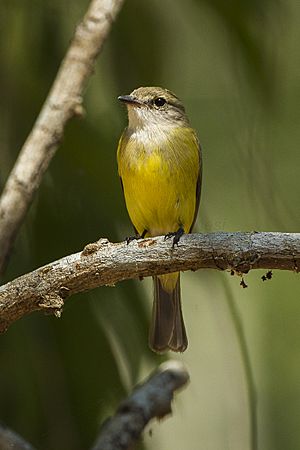Lemon-bellied flyrobin facts for kids
Quick facts for kids Lemon-bellied flyrobin |
|
|---|---|
 |
|
| Conservation status | |
| Scientific classification | |
| Genus: |
Microeca
|
| Species: |
flavigaster
|
| Synonyms | |
|
|
The lemon-bellied flyrobin or lemon-bellied flycatcher (Microeca flavigaster) is a small, colorful bird. It belongs to the Petroicidae family. You can find this bird in Australia, Indonesia, and Papua New Guinea. It loves living in warm, wet places. These include subtropical or tropical moist lowland forests and mangrove forests near the coast.
Contents
What's in a Name?
A scientist named John Gould first described this bird in 1843. He found a specimen in Port Essington in the Northern Territory, Australia. The bird's scientific name, flavigaster, comes from two words. Flavus is a Latin word meaning 'yellow'. Gaster is an Ancient Greek word meaning 'belly'. So, its name literally means 'yellow-bellied'.
There are four main types, or subspecies, of the lemon-bellied flyrobin:
- The flavigaster type lives across the top of the Northern Territory.
- The flavissima type is found in Cape York and New Guinea.
- The laetissima type lives along the central-northern Queensland coast.
- The tormenti type lives in the Kimberley area of northwestern Australia.
For many years, the tormenti type, also called the Kimberley flyrobin, was thought to be a completely different species. However, scientists found that these birds could have babies with the flavigaster type. This happened where their homes met, like near Cambridge Gulf. Because they could have babies together, scientists like Les Christidis decided they were just different types of the same species. The tormenti type is special because it doesn't have the yellow color that the other types do.
People also call this bird by other names. These include lemon-breasted flycatcher, yellow-bellied flycatcher, or yellow-breasted flycatcher. The tormenti type is sometimes called the brown-tailed flycatcher.
How to Spot a Lemon-bellied Flyrobin
An adult lemon-bellied flyrobin is about 11.5 centimetres (4.5 in) long. That's about the length of your hand! Both male and female birds look very similar.
The most common type, flavigaster, has a bright lemon-yellow belly. It has a white throat and a grey face with a white stripe above its eye. Its back and upper parts are olive-brown.
The tormenti type looks a bit different. It has white underparts instead of yellow. Its upper parts are more grey. This type also has a longer beak and tail, and it's a bit bigger overall.
The flavissima type is like flavigaster but has more yellow on its upper parts and throat. It also has a yellow eyebrow and a shorter tail. The laetissima type is similar to flavigaster but has a shorter tail and beak, and it's larger.
Where They Live
The lemon-bellied flyrobin lives in a wide area. You can find it from the Ord River in western Australia all the way to the coast of Queensland. These birds like to live in specific kinds of places. They are often found in mangrove forests, which are forests that grow in salty water along the coast. They also live in paperbark swamp forests and other woodlands.
What They Eat
The lemon-bellied flyrobin is an insectivore. This means it mostly eats insects. It's quite good at hunting! It usually looks for its food in the leaves or dead branches of trees and bushes. It only rarely hunts for food on the ground.
Scientists studying these birds in Kakadu National Park saw them catch some pretty big insects, sometimes over 2 centimetres (0.79 in) long. The birds often catch insects by "hawking" or "sallying." This means they fly out from a perch, grab an insect in mid-air, and then return to their perch.
Life Cycle and Reproduction
Lemon-bellied flyrobins breed during the warmer months, usually from August to February. They can raise one or two families of chicks each season.
Their nest is quite small and shaped like a dish. They build it using bark and grasses. They usually place the nest in the fork of a tree branch. The female bird lays a single egg. This egg is about 19 by 14 millimetres (0.75 by 0.55 in) in size. It is pale blue with brownish markings.
See also
 In Spanish: Petroica limón para niños
In Spanish: Petroica limón para niños


